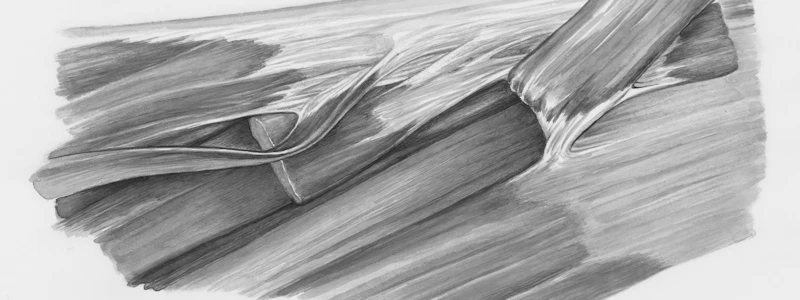Podcast
Questions and Answers
Which movement of the trunk involves bending forward?
Which movement of the trunk involves bending forward?
- Flexion (correct)
- Extension
- Gliding
- Rotation
- Lateral flexion
At which type of joint do gliding movements of the trunk occur?
At which type of joint do gliding movements of the trunk occur?
- Pivot
- Hinge
- Primary cartilaginous
- Synovial (correct)
- Fibrous
Which structure unites the left and right abdominal muscles along the midline?
Which structure unites the left and right abdominal muscles along the midline?
- Linea alba (correct)
- Tendinous intersections
- Abdominal aponeurosis
- Inguinal ligament
- Rectus sheath
Which muscle is located on either side of the midline of the anterior abdominal wall?
Which muscle is located on either side of the midline of the anterior abdominal wall?
What is the arrangement of the anterolateral abdominal muscles from superficial to deep?
What is the arrangement of the anterolateral abdominal muscles from superficial to deep?
Why is it functionally adaptive for the stomach's smooth muscle to contract in three directions?
Why is it functionally adaptive for the stomach's smooth muscle to contract in three directions?
What type of joint allows compression in the trunk?
What type of joint allows compression in the trunk?
What functional advantage does the three-layered structure of the anterolateral abdominal wall provide?
What functional advantage does the three-layered structure of the anterolateral abdominal wall provide?
Which muscle of the anterior abdominal wall is most likely involved in flexion of the trunk from a supine position?
Which muscle of the anterior abdominal wall is most likely involved in flexion of the trunk from a supine position?
Which muscle of the anterior abdominal wall is primarily responsible for increasing pressure within the abdominal cavity?
Which muscle of the anterior abdominal wall is primarily responsible for increasing pressure within the abdominal cavity?
When you contract your abdominal muscles to increase intra-abdominal pressure, which muscle layer is primarily responsible for this action?
When you contract your abdominal muscles to increase intra-abdominal pressure, which muscle layer is primarily responsible for this action?
How does the three-layered design of the abdominal wall contribute to core stability?
How does the three-layered design of the abdominal wall contribute to core stability?
Which two muscles of the anterior abdominal wall work together to compress the abdominal cavity and support trunk flexion?
Which two muscles of the anterior abdominal wall work together to compress the abdominal cavity and support trunk flexion?
How do the erector spinae muscles contribute to controlling trunk flexion?
How do the erector spinae muscles contribute to controlling trunk flexion?
During forward flexion of the trunk, what is the primary role of the erector spinae muscles?
During forward flexion of the trunk, what is the primary role of the erector spinae muscles?
What type of muscle contraction do the erector spinae muscles primarily undergo to control trunk flexion?
What type of muscle contraction do the erector spinae muscles primarily undergo to control trunk flexion?
Why is the control of trunk flexion by the erector spinae muscles important?
Why is the control of trunk flexion by the erector spinae muscles important?
Flashcards are hidden until you start studying
Study Notes
Trunk and Abdominal Muscles
- Flexion: Bending forward (e.g., touching your toes).
- Extension: Straightening the trunk from a flexed position.
- Lateral Flexion: Bending to the side, left or right.
- Rotation: Twisting the trunk to the left or right.
- Gliding: Small movements between vertebral joints.
- Synovial Joints: Allow gliding movements in the trunk.
- Linea Alba: Structure that unites left and right abdominal muscles along the midline.
- Rectus Abdominis: Located on either side of the midline of the anterior abdominal wall.
- Anterolateral Abdominal Muscles: Arranged from superficial to deep:
- External Oblique
- Internal Oblique
- Transversus Abdominis
- Stomach's Smooth Muscle: Contracts in three directions to allow the stomach as an entire organ to contract.
- Secondary Cartilaginous Joint: Allows compression in the trunk.
- Anterolateral Abdominal Wall (3 Layers): Provides strength and structural support to the abdomen.
- Rectus Abdominis: Primarily involved in flexing the trunk from a supine position.
- Transversus Abdominis: Primarily responsible for increasing pressure within the abdominal cavity.
- Three-Layered Design of the Abdominal Wall: Enhances the abdominal wall's ability to withstand pressure and resist injury, contributing to core stability.
- Rectus Abdominis and External Oblique: Work together to compress the abdominal cavity and support trunk flexion.
- Erector Spinae Muscles: Act as stabilizers to resist excessive flexion of the trunk.
- Erector Spinae Muscles During Flexion: Eccentrically control the descent and prevent sudden flexion.
- Control of Trunk Flexion by Erector Spinae Muscles: Stabilizes the spine during forward bending movements.
- Erector Spinae Muscles during Flexion: Primarily undergo eccentric contraction.
Studying That Suits You
Use AI to generate personalized quizzes and flashcards to suit your learning preferences.




